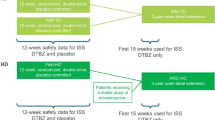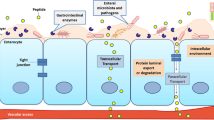Abstract
The interaction of dicumarol and phenothiazine neuroleptics binding to α1-acid glycoprotein (AGP) was investigated by circular dichroism (CD) and equilibrium dialysis. The induced CD spectra of the dicumarol–AGP complex were affected differently by the different substituents of the phenothiazine molecule. The sign of the induced Cotton effect of dicumarol bound to AGP was reversibly changed with the introduction of the propyldimethylamine substituent at position 10 or chloride group at position 2 of the phenothiazine molecule. Chlorpromazine, which contains both of these substituents reversed the sign of the induced Cotton effect with the highest intensity. The addition of trifluoperazine, fluphenazine, and promethazine containing neither of the two substituents generated a new negative CD band. However, the addition of opromazine, which contains sulfoxide at position 5, decreased the CD intensity of the dicumarol–AGP complex without changing the shape of the CD spectra. Equilibrium dialysis studies revealed that the interaction of dicumarol–AGP with phenothiazine derivatives occurred simultaneously, and the interaction followed a cooperative and anticooperative binding model. Further, among the six phenothiazine derivatives that reversed the signs of the induced Cotton effects of the dicumarol–AGP complex, a linear relationship was observed between coupling constants and the difference in the induced optical ellipticity. The opromazine and dicumarol interaction was competitive for a common binding site on the AGP molecule. Removal of sialic acid did not have any effect on this interaction. These data support the hypothesis that the acidic and the basic drug binding sites overlap each other.
Similar content being viewed by others
REFERENCES
P. A. Routledge. The plasma protein binding of basic drugs. Br. J. Clin. Pharmacol. 22:499–506 (1986).
K. M. Piafsky. Disease-induced changes in the plasma binding of basic drugs. Clin. Pharmacokinet. 5:246–262 (1980).
J. J. Mackichan. Pharmacokinetic consequences of drug displacement from blood and tissue protein. Clin. Pharmacokinet. 9:32–41 (1984).
M. Otagiri, R. Yamamichi, T. Imai, Y. Imamura, and A. Takadate. Study on the binding of dicumarol to α1-acid glycoprotein using circular dichroism spectroscopy. Chem. Pharm. Bull. 36: 4958–4962 (1988).
M. Otagiri, R. Yamamichi, T. Maruyama, T. Imai, A. Suenaga, Y. Imamura, and K. Kimachi. Drug binding to α1-acid glycoprotein studied by circular dichroism. Pharm. Res. 6:156–159 (1989).
M. Otagiri, T. Miyoshi, R. Yamamichi, T. Maruyama, and J. H. Perrin. Effects of tricyclic drug on induced circular dichroism spectra of dicumarol bound to α1-acid glycoprotein. Biochem. Pharmacol. 42:729–733 (1991).
S. Primozic and P. J. McNamara. Effect of sialylation state of α1-acid glycoprotein on propranolol binding. J. Pharm. Sci. 74:473–475 (1985).
L. Warren. The thiobarbituric acid assay of sialic acids. J. Biol. Chem. 234:1971–1975 (1959).
U. Kragh-Hansen. Evidence for a large and flexible region of human serum albumin possessing high affinity binding sites for salicylate, warfarin and other ligands. Mol. Pharmacol. 34:160–171 (1988).
C. F. Chignell. Spectroscopic technique for study of drug interaction with biological system. Adv. Drug Res. 5:55–94 (1970).
Author information
Authors and Affiliations
Rights and permissions
About this article
Cite this article
Miyoshi, T., Yamamichi, R., Maruyama, T. et al. Reversal of Signs of Induced Cotton Effects of Dicumarol-α1-Acid Glycoprotein Systems by Phenothiazine Neuroleptics Through Ternary Complexation. Pharm Res 9, 845–849 (1992). https://doi.org/10.1023/A:1015880327911
Issue Date:
DOI: https://doi.org/10.1023/A:1015880327911




